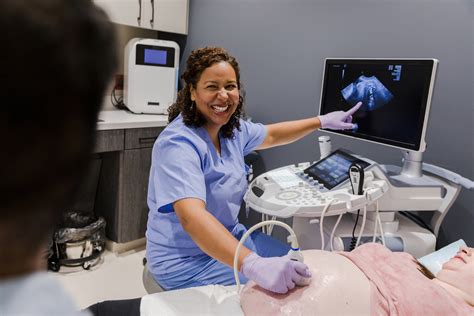Introduction
Sonographers, also known as diagnostic medical sonographers, play a vital role in the healthcare industry by utilizing ultrasound technology to visualize and assess internal organs and structures. The demand for skilled sonographers is constantly growing due to advances in medical technology and the increasing need for non-invasive diagnostic imaging procedures. This article provides a comprehensive overview of the sonographer salary in Maryland, outlining factors that influence earnings, career advancement opportunities, and the benefits of pursuing a career in this field.

Education and Experience
The level of education and experience significantly impact a sonographer’s salary. According to the Bureau of Labor Statistics (BLS), sonographers with a bachelor’s degree in sonography earn a median annual salary of $79,840. Those with an associate’s degree or certificate in sonography typically earn a lower salary, around $71,260. Sonographers with additional certifications and specialized training, such as cardiac or vascular sonography, can command higher salaries.
Location
Geographical location also plays a role in determining sonographer salary. The BLS reports that sonographers in the Baltimore-Columbia-Towson metropolitan area earned a median annual salary of $88,010 in May 2021. This is higher than the national median salary for sonographers. Sonographers working in rural areas or less populated regions may earn slightly lower salaries.
Employer Type
The type of employer can also influence sonographer salary. Sonographers employed by hospitals and clinics typically earn higher salaries than those working in private medical practices or outpatient centers. Government agencies, such as the Veterans Administration (VA) and the National Institutes of Health (NIH), also offer competitive salaries and benefits to sonographers.
Demand and Supply
The demand for qualified sonographers is projected to grow significantly in the coming years. The aging population, increasing use of ultrasound technology in medical diagnosis, and the expansion of healthcare facilities are all contributing factors to the high demand for sonographers. This increased demand is expected to drive salaries upward in the future.
Sonographers have several opportunities for career advancement within the field. With additional education and training, they can specialize in specific areas of sonography, such as echocardiography, vascular sonography, or obstetric and gynecologic sonography. Sonographers with advanced degrees, such as a master’s or doctorate, can pursue leadership roles or become educators in the field.
Pursuing a career as a sonographer offers numerous benefits, including:
- High earning potential: Sonographers are well-paid professionals with a median annual salary that exceeds many other healthcare occupations.
- Job security: The demand for sonographers is high and is expected to continue to grow in the future.
- Variety of work: Sonographers work in various settings, including hospitals, clinics, private practices, and research institutions.
- Non-invasive procedures: Sonography is a non-invasive diagnostic technique that does not involve radiation exposure.
- Opportunities for advancement: Sonographers have multiple pathways for career advancement, including specialization, leadership, and education.
Individuals considering a career as a sonographer should avoid the following common mistakes:
- Underestimating the importance of formal education: A formal education in sonography is essential for success in the field.
- Not specializing: Specialization in a specific area of sonography can increase earning potential and career advancement opportunities.
- Neglecting continuing education: The field of sonography is constantly evolving, and it is crucial for sonographers to stay updated with the latest techniques and advancements.
- Not networking: Networking with other sonographers, healthcare professionals, and potential employers can lead to valuable career opportunities.
- Overlooking the physical demands of the job: Sonographers spend long hours on their feet and may need to maneuver patients into various positions for imaging.
To become a sonographer in Maryland, individuals must follow the following steps:
- Obtain a bachelor’s degree in sonography or a related field.
- Complete an accredited sonography program.
- Pass the Sonography Principles and Instrumentation (SPI) exam administered by the American Registry for Diagnostic Medical Sonography (ARDMS).
- Obtain a state license.
- Consider specializing in a specific area of sonography.
A career as a sonographer in Maryland offers a rewarding path with high earning potential, job security, and numerous opportunities for advancement. With advancements in medical technology and the increasing demand for non-invasive diagnostic imaging procedures, the profession of sonography is expected to continue to grow in the years to come. By following the steps outlined above and avoiding common mistakes, individuals can position themselves for a successful and fulfilling career in this dynamic field.
Tables:
Table 1: Sonographer Earnings by Education Level
| Education Level | Median Annual Salary |
|---|---|
| Bachelor’s Degree | $79,840 |
| Associate’s Degree or Certificate | $71,260 |
Table 2: Sonographer Earnings by Location
| Location | Median Annual Salary |
|---|---|
| Baltimore-Columbia-Towson, MD | $88,010 |
| United States | $76,540 |
Table 3: Sonographer Earnings by Employer Type
| Employer Type | Median Annual Salary |
|---|---|
| Hospitals and Clinics | $80,630 |
| Private Medical Practices and Outpatient Centers | $74,020 |
Table 4: Sonographer Job Outlook
| Year | Projected Growth Percentage |
|---|---|
| 2020-2030 | 12% |
Keywords:
- Sonographer salary MD
- Sonography career
- Diagnostic medical sonographer
- Ultrasound technology
- Medical imaging
